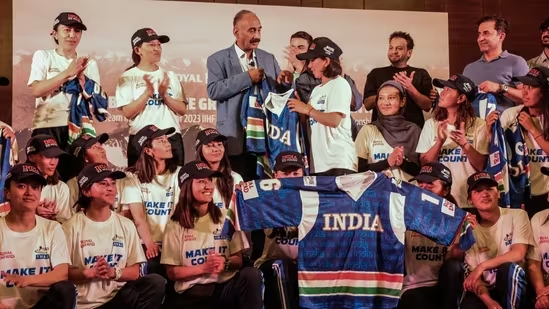Welcome thaw for women’s ice hockey in Ladakh
At 3,000 m above sea level, the Ladakh winter is harsh with the temperature dipping to almost minus 30 degrees Celsius. While life comes to a frozen halt elsewhere, it’s playtime for scores of young women ice-hockey players on the country’s highest plateau. The two-and-a-half months of brutal winter provides them an opportunity to chase their dreams. So, they gear up and head to the nearest frozen lake to play.

“Ice hockey is a way of life for us,” says Noor Jahan, 33, the India team goalkeeper. She is the face of the team that will compete in the Asia-Oceania Championships in Thailand this month. Eighteen of the 20 in the team are from Ladakh.
The eight-team competition also features Iran, Kyrgyz Republic, Kuwait, Malaysia, Singapore, the UAE and Thailand. With just three wins in 13 internationals, India’s aim is to get exposure.
“We’re really looking forward to this opportunity. This event is being held after three years due to Covid, so we are really excited,” Jahan, who has been in the national team since 2016, says. “Despite the time lost to Covid, women’s ice hockey has really grown in Ladakh. Earlier, we had trouble getting 20 girls, but now there is no dearth of interest.”
Six teams took part in the nationals held earlier in the year, including Maharashtra, Haryana and Telangana though Ladakh dominated.
“Ice hockey has been popular in our parts for at least 40 years, but it took a while for women to take up the sport,” says Jahan, who was introduced to the sport 20 years ago by her cousin, who played in the national men's team.
“I used to watch him play, and since I had no gear, I would steal his skates and hockey stick and play. One day he got fed up and gave me a pair of handmade army skates.”
Jahan's early lessons came from watching the men’s local matches. Gradually more girls were drawn to ice hockey. “Initially, no one paid attention to us. There was no proper rink in Ladakh anyway, and whatever suitable natural ice we had was used by the men's teams. The girls would get the space in the afternoons or evenings when the ice was in a very bad condition.”
Acknowledgment came from unexpected quarters. “Foreign travellers, especially from USA and Canada, began to notice us and started donating their equipment. Ours is an expensive sport and it is not possible for our families to support us financially. A standard ice-hockey gear costs between ₹2-3 lakh.”
Playing with sub-standard equipment can be hazardous. In a match against Thailand, Jahan's worn-out glove tore, exposing her fingers. “I realised only after the puck struck and I felt the pain. I would say we have come a long way from there.”
Ladakh now has around 30-40 ice hockey clubs, including the Ladakh Women's Ice Hockey Club, of which Jahan is a general secretary. She is also executive council member of the Ice Hockey Association of India and heads its women's development wing.
Jahan is also an art conservationist with a PhD in the subject from National Museum Institute. She is a co-founder of Shesrig Ladakh, an art conservation atelier. She works primarily with Thangka, wall, scroll and mural paintings.
“For nine-and-a-half months, I restore paintings and dream of playing. For the rest two-and-a-half months, I live my dream.”
Disclaimer: The copyright of this article belongs to the original author. Reposting this article is solely for the purpose of information dissemination and does not constitute any investment advice. If there is any infringement, please contact us immediately. We will make corrections or deletions as necessary. Thank you.







